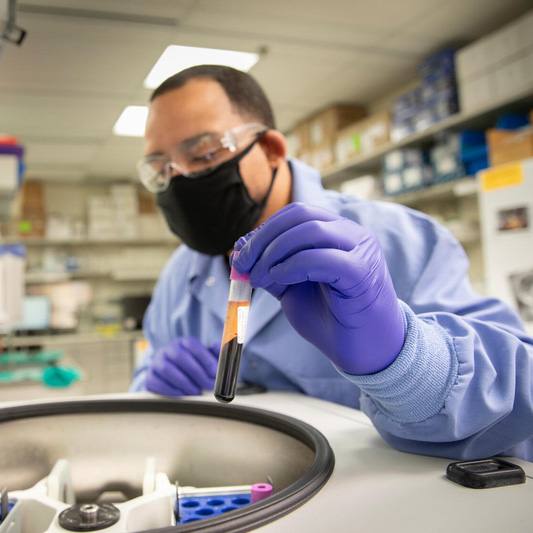-
Discovery Science
Diabetes research advances with new enzyme publication from Mayo
While treatment for diabetes has progressed, there is still no cure. As a person with type 1 diabetes, Paul Belmonte, Ph.D., knows that well. So it’s no surprise that he asked to research something related to that disease when, as a Mayo Clinic graduate student, he rotated into the lab of immunologist Virginia Shapiro, Ph.D. Now, with a publication in The Journal of Immunology, he and the team identify a new role for a little-studied enzyme that could have big implications for diabetes therapies in the future.

Immune System Misunderstanding
Diabetes is an autoimmune disease — the body’s immune system mistakenly targets the pancreatic cells that make insulin, called beta cells. At a certain point the damage becomes so widespread that insulin production drops. The sugar (glucose) that insulin normally removes from blood instead builds up to dangerous levels. Most of the focus in diabetes research has been target-locked on the adaptive cells of the immune system, such as T cells.
“Type 1 diabetes is not something I’ve done before,” says Dr. Shapiro.
But it’s a daily companion for Dr. Belmonte.
“I don’t remember a time before diabetes – I was diagnosed as a child,” he says. “Even with all the technological advances like artificial pancreas systems, it’s an incredibly difficult disease to manage and demands so much mentally and physically 24/7/365.”
Simply put, he says, he wanted to study type 1 diabetes because he wanted to give people a break.
“I don’t want anybody to have to constantly think about every meal and insulin dose, when and how much to exercise, or worry about any devastating complications like blindness or kidney disease. I want to give people a chance to breath and say, ‘I remember when I had type 1 diabetes.’”
When presented with Dr. Belmonte’s request, Dr. Shapiro decided to look at the disease from a different angle. She started thinking about the innate immune system, knowing those cells are involved in destruction of beta cells as well. After considering different options, she had the idea to investigate an enzyme linked to carbohydrate processing in the body. They were able to pursue this line of research with federal funding, as well as support for Dr. Belmonte from the Wilbur T. and Grace C. Pobanz Predoctoral Fellowship.
“The Pobanz fellowship has been an amazing gift and has allowed me to communicate my research to audiences and establish collaborations with scientists across the nation,” says Dr. Belmonte.

Boosting Protection
The enzyme is called ST8SIA6. It boosts the body’s chemical reactions – assembly and disassembly – related to carbohydrates.
“Almost nothing is known about ST8SIA6,” says Dr. Shapiro. “This paper is the first use of ST8SIA6 to manipulate the immune response.” The authors report that ST8SIA6 creates a binding site for a protein, SIGLEC-E, that may shut down an inflammatory response controlled by macrophages.
Macrophages have a SIGLEC-E receptor on their surface that can link to proteins called ligands on the surface of the beta cell, like two matching pieces of a puzzle. The researchers developed a line of mice that expressed ST8SIA6 in pancreatic beta cells, and then induced diabetes in the mice to determine the effect of this overexpression in comparison to littermate controls.
“We found that ST8SIA6 expression mitigates high levels of glucose in this model,” says Dr. Shapiro. Having a level of the enzyme that was higher than the normal level balanced the over-reaction of macrophages that is characteristic of diabetes.
“While this is just a first step toward a new therapeutic option, it’s important to continue to understand immune-mediated attack of pancreatic beta cells,” says Dr. Shapiro. “Hopefully, one day this will help design treatments to stop the destruction or lead to an actual cure.”
From Dr. Belmonte’s perspective, the time spent in Dr. Shapiro’s lab was instrumental as he begins his career.
“My experience in the lab taught me persistence,” he says. “Because there is little known about ST8SIA6, there were times when we had to take a step back and think outside the box. Dr. Shapiro’s mentorship was instrumental in this.”
Dr. Belmonte says the research helped him understand the autoimmune process driving type 1 diabetes and the tools that can be used to investigate it.
“Moving forward, I want to take this training and apply it to regenerative medicine – can we replace beta cells, and protect them from recurrent immune assault? I really think we will get there in my lifetime,” he says.
Other authors, all from Mayo Clinic, include: Michael Shapiro, Ph.D., Matthew Rajcula, and Shaylene McCue.
Interested in reading more?
- To read the article abstract, visit PubMed.
- To learn more about the disease, visit the Mayo Clinic information page on the diabetes.
- To find a community and support for day-to-day life with type 1 diabetes, visit JDRF.
- To read about Mayo’s involvement in the discovery of insulin, read “A Line in the Sand.”
- To learn more about the Mayo Clinic Graduate School of Biomedical Sciences, see their overview page.







